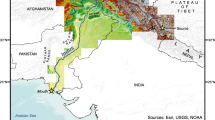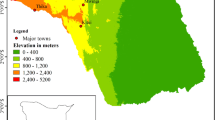Abstract
A steady-state fluvial system can transition to a transient state solely by changing the uplift/subsidence rate due to tectonic perturbations, while the rate of erosion remains relatively constant in an area with uniform lithology. In such cases, cause and effect exhibit a one-to-one relationship, making it easy to establish quantitative relationships between morphometric indices and active tectonics. However, major structural boundaries, like thrust units, often coincide with lithological boundaries, especially in orogenic belts like the Himalayas. Further complexities arise when the rate of erosion changes along the river course. Decoupling the effect of rock erodibility from active tectonics in morphometric indices can prove to be extremely challenging. The uplift rate can be determined through GPS and remote sensing studies, whereas assessing the erodibility of rocks remains difficult, as it depends on several external factors (such as rainfall and stream power) and internal factors (like rock strength, rock, and fabric). As a solution, we propose a remote sensing-based method that quantifies erodibility based on the volumetric changes between summit and base elevations of a SWATH profile polygon with uniform lithology. This method incorporates the effects of rock fabric, strength, and various erosional agents, such as rainfall and stream power, expressed as an absolute change in rock volume. The technique is then applied and tested in the study areas. The strong correlation between the erodibility coefficient and the steepness index suggests a novel approach to solving the erodibility problem in tectonic geomorphology.
Graphical abstract














Similar content being viewed by others
Data availability
The data sources are mentioned in supplementary table.
References
Abrahami R, van der Beek P, Huyghe P, Hardwick E, Carcaillet J (2016) Decoupling of long-term exhumation and short-term erosion rates in the Sikkim Himalaya. Earth Planet Sci Lett. https://doi.org/10.1016/j.epsl.2015.10.039
Acharyya S, Ray K (1977) Geology of the Darjeeling–Sikkim himalaya. In: Fourth International Gondwana Symposium (Calcutta). Geological Survey of India. Kolkata
Anand AK, Pradhan SP (2019) Assessment of active tectonics from geomorphic indices and morphometric parameters in part of Ganga basin. J Mt Sci 16:1943–1961. https://doi.org/10.1007/s11629-018-5172-2
Anderson RS, Anderson SP (2010) Geomorphology: the mechanics and chemistry of landscapes. Cambridge University Press
Bahrami S, Capolongo D, Mofrad MR (2020) Morphometry of drainage basins and stream networks as an indicator of active fold growth (Gorm anticline, Fars Province, Iran). Geomorphology 355:25. https://doi.org/10.1016/j.geomorph.2020.107086
Basu S (2013) Geology of Sikkim state and Darjeeling district of West Bengal. Geological Society of India
Bierman PR, Bender AM, Christ AJ, Corbett LB, Halsted CT, Portenga EW, Schmidt AH (2021) Dating by cosmogenic nuclides. Encyclopedia of geology. Academic Press, Oxford, pp 101–115
Bursztyn N, Pederson JL, Tressler C, Mackley RD, Mitchell KJ (2015) Rock strength along a fluvial transect of the Colorado Plateau—quantifying a fundamental control on geomorphology. Earth Planet Sci Lett. https://doi.org/10.1016/j.epsl.2015.07.042
Dahlen FA, Suppe J, Davis D (1984) Mechanics of fold-and-thrust belts and accretionary wedges: cohesive coulomb theory. J Geophys Res 89:10087–10101. https://doi.org/10.1029/JB089iB12p10087
Das D, Mallik J, Das S, Deb T, Das A, Bandyopadhyay K (2021) Active thrust induced realignment of recent near-surface stresses in the Darjeeling-Sikkim Himalayas: reasons and implications. J Struct Geol. https://doi.org/10.1016/j.jsg.2021.104311
Davis D, Suppe J, Dahlen FA (1983) Mechanics of fold-and-thrust belts and accretionary wedges. J Geophys Res 88:1153–1172. https://doi.org/10.1029/JB088iB02p01153
Disaster Management and Mitigation Centre, Uttarakhand 2014. Geological investigations in Rudraprayag district with special reference to mass instability
Dortch JM, Owen LA, Schoenbohm LM, Caffee MW (2011) Asymmetrical erosion and morphological development of the central Ladakh Range, northern India. Geomorphology. https://doi.org/10.1016/j.geomorph.2011.08.014
el Hamdouni R, Irigaray C, Fernández T, Chacón J, Keller EA (2008) Assessment of relative active tectonics, southwest border of the Sierra Nevada (southern Spain). Geomorphology. https://doi.org/10.1016/j.geomorph.2007.08.004
Flint JJ (1974) Stream gradient as a function of order, magnitude, and discharge. Water Resourc Res. https://doi.org/10.1029/WR010i005p00969
Gailleton B, Sinclair HD, Mudd SM, Graf ELS, Mațenco LC (2021) Isolating lithologic versus tectonic signals of river profiles to test orogenic models for the eastern and southeastern Carpathians. J Geophys Res Earth Surf. https://doi.org/10.1029/2020JF005970
Gallen SF (2018) Lithologic controls on landscape dynamics and aquatic species evolution in post-orogenic mountains. Earth Planet Sci Lett 493:150–160. https://doi.org/10.1016/j.epsl.2018.04.029
Ghosh A (1956) Recent advances in geology and structures of the Eastern Himalaya, in: Proceedings 43rd Indian Science Congress
Godard V, Lavé J, Carcaillet J, Cattin R, Bourlès D, Zhu J (2010) Spatial distribution of denudation in Eastern Tibet and regressive erosion of plateau margins. Tectonophysics. https://doi.org/10.1016/j.tecto.2009.10.026
Gonzalez VS, Bierman PR, Fernandes NF, Rood DH (2016) Long-term background denudation rates of southern and southeastern Brazilian watersheds estimated with cosmogenic 10Be. Geomorphology 268:54–63. https://doi.org/10.1016/j.geomorph.2016.05.024
GSI [Geological Survey of India], 2001. District resource Map. GSI
Hack JT (1973) Stream-profile analysis and stream-gradient index. J Res US Geol Surv 1(4):421–429
Hack JT (1957) Studies of longitudinal stream profiles in Virginia and Maryland. USGS Professional Paper 249.
Harel MA, Mudd SM, Attal M (2016) Global analysis of the stream power law parameters based on worldwide 10Be denudation rates. Geomorphology 268:184–196. https://doi.org/10.1016/j.geomorph.2016.05.035
Heimsath AM, Jungers MC (2013) Processes, transport, deposition, and landforms: quantifying creep. Treatise on geomorphology. Elsevier, Amsterdam, pp 138–151. https://doi.org/10.1016/B978-0-12-374739-6.00158-5
Howard AD (1994) A detachment-limited model of drainage basin evolution. Water Resour Res 30(7):2261–2285. https://doi.org/10.1029/94WR00757
Jade S, Mukul M, Bhattacharyya AK, Vijayan MSM, Jaganathan S, Kumar A, Gaur VK (2007) Estimates of interseismic deformation in Northeast India from GPS measurements. Earth Planet Sci Lett 263(3–4):221–234. https://doi.org/10.1016/j.epsl.2007.08.031
Kirby E, Whipple KX (2012) Expression of active tectonics in erosional landscapes. J Struct Geol. https://doi.org/10.1016/j.jsg.2012.07.009
Kühni A, Pfiffner OA (2001) The relief of the Swiss Alps and adjacent areas and its relation to lithology and structure: topographic analysis from a 250-m DEM. Geomorphology. https://doi.org/10.1016/S0169-555X(01)00060-5
Kumar G (2005) Geology of Uttar Pradesh and Uttaranchal. Geological Society of India, Bangalore, p 383
Kumar D, Thakur M, Dubey CS, Shukla DP (2017) Landslide susceptibility mapping & prediction using support vector machine for Mandakini River Basin, Garhwal Himalaya, India. Geomorphology 295:115–125. https://doi.org/10.1016/j.geomorph.2017.06.013
Lague D, Hovius N, Davy P (2005) Discharge, discharge variability, and the bedrock channel profile. J Geophys Res Earth Surf. https://doi.org/10.1029/2004JF000259
Landry KR, Coutand I, Whipp DM, Grujic D, Hourigan JK (2016) Late Neogene tectonically driven crustal exhumation of the Sikkim Himalaya: Insights from inversion of multithermochronologic data. Tectonics. https://doi.org/10.1002/2015TC004102
Larsen IJ, Montgomery DR (2012) Landslide erosion coupled to tectonics and river incision. Nat Geosci 5(7):468–473. https://doi.org/10.1038/ngeo1479
Mahmood SA, Gloaguen R (2012) Appraisal of active tectonics in Hindu Kush: insights from DEM derived geomorphic indices and drainage analysis. Geosci Front. https://doi.org/10.1016/j.gsf.2011.12.002
Mitra G, Kathakali B, Malay M (2010) The lesser himalayan duplex in Sikkim: implications for variations in Himalayan shortening. J Geol Soc India 75:289–301. https://doi.org/10.1007/s12594-010-0016-x
Moglen GE, Bras RL (1995) The effect of spatial heterogeneities on geomorphic expression in a model of basin evolution. Water Resour Res 31(10):2613–2623. https://doi.org/10.1029/95WR02036
Naithani AK, Kumar D, Prasad C (2002) The catastrophic landslide of 16 July 2001 in Phata Byung area Rudrapryag District, Garhwal Himalaya, India. Curr Sci 82(8):921–923
Pratt-Sitaula B, Burbank DW, Heimsath A, Ojha T (2004) Landscape disequilibrium on 1000–10,000 year scales Marsyandi River, Nepal, central Himalaya. Geomorphology. https://doi.org/10.1016/j.geomorph.2003.07.002
Ramakrishnan M, Vaidyanadhan R (2010) Geology of India (vol. 1 & 2). GSI Publications, 2(1).
Reitano R, Faccenna C, Funiciello F, Corbi F, Sternai P, Willett SD, Sembroni A, Lanari R (2022) Sediment recycling and the evolution of analog orogenic wedges. Tectonics 41(2):e2021. https://doi.org/10.1029/2021TC006951
Sambasiva Rao M, Rambabu G (2015) Hydro-Geomorphology and hydrogeology of the Pennar river basin, India: implications on basin scale surface and ground water resource management. Environ Manag River Basin Ecosyst 3:319–328
Schwanghart W, Kuhn NJ (2010) TopoToolbox: A set of Matlab functions for topographic analysis. Environ Modell Softw. https://doi.org/10.1016/j.envsoft.2009.12.002
Sklar L, Dietrich WE (1998) River longitudinal profiles and bedrock incision models: Stream power and the influence of sediment supply. In: Geophysical Monograph Series. https://doi.org/10.1029/GM107p0237
Stock JD, Montgomery DR (1999) Geologic constraints on bedrock river incision using the stream power law. J Geophys Res Solid Earth. https://doi.org/10.1029/98jb02139
Telbisz T, Kovács G, Székely B, Szabó J (2013) Topographic swath profile analysis: a generalization and sensitivity evaluation of a digital terrain analysis tool. Zeitschrift Fur Geomorphologie. https://doi.org/10.1127/0372-8854/2013/0110
Thiede RC, Bookhagen B, Arrowsmith JR, Sobel ER, Strecker MR (2004) Climatic control on rapid exhumation along the Southern Himalayan Front. Earth Planet Sci Lett. https://doi.org/10.1016/j.epsl.2004.03.015
Valdiya KS (1980) Geology of Kumaun Lesser Himalaya. Wadia Institutes of Himalayan Geology, Dehradun, 291 pp
Whipple KX, Tucker GE (1999) Dynamics of the stream-power river incision model: implications for height limits of mountain ranges, landscape response timescales, and research needs. J Geophys Res Solid Earth. https://doi.org/10.1029/1999jb900120
Willett SD, Brandon MT (2013) Some analytical methods for converting thermochronometric age to erosion rate. Geochem Geophys Geosyst 14(1):209–222. https://doi.org/10.1029/2012GC004279
Wobus C, Whipple KX, Kirby E, Snyder N, Johnson J, Spyropolou K, Crosby B, Sheehan D (2006) Tectonics from topography: procedures, promise, and pitfalls. Spec Pap Geol Soc Am. https://doi.org/10.1130/2006.2398(04)
Zondervan JR, Stokes M, Boulton SJ, Telfer MW, Mather AE (2020) Rock strength and structural controls on fluvial erodibility: implications for drainage divide mobility in a collisional mountain belt. Earth Planet Sci Lett. https://doi.org/10.1016/j.epsl.2020.116221
Acknowledgements
This work is a part of DD’s doctoral research work. We thank Mr. Atul Kumar Rai and Mr. Zafar Beg for helping us with the GIS techniques. We also thank Mr. Krishanu Bandyopadhyay for his critical comments and discussions. No grant was received or necessary for conducting this work. We also thank Laura Giambiagi, Riccardo Lanari, and another anonymous reviewer for their valuable suggestion which significantly improved the manuscript. We also extend our gratitude to the Editor-in-chief, Dr. Ulrich Riller for his constant feedback to improve the manuscript.
Author information
Authors and Affiliations
Corresponding author
Ethics declarations
Conflict of interest
The authors declare none.
Supplementary Information
Below is the link to the electronic supplementary material.
Rights and permissions
Springer Nature or its licensor (e.g. a society or other partner) holds exclusive rights to this article under a publishing agreement with the author(s) or other rightsholder(s); author self-archiving of the accepted manuscript version of this article is solely governed by the terms of such publishing agreement and applicable law.
About this article
Cite this article
Das, D., Mallik, J. Establishment of the relationship between rock strength and topography: a novel approach to river morphometric analysis decoupling rock erodibility from active tectonics. Int J Earth Sci (Geol Rundsch) 112, 2247–2265 (2023). https://doi.org/10.1007/s00531-023-02348-9
Received:
Accepted:
Published:
Issue Date:
DOI: https://doi.org/10.1007/s00531-023-02348-9




